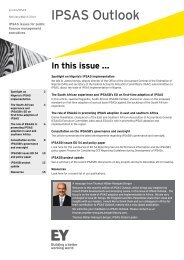You also want an ePaper? Increase the reach of your titles
YUMPU automatically turns print PDFs into web optimized ePapers that Google loves.
Africa in 2030 – Prospects for a Continent in TransitionDr. Donald KaberukaDonald Kaberuka is President of the African Development Bank, the leading regional developmentfinance institution. The Bank promotes economic and social progress in Africa through loans, equityinvestments and technical assistance.The year 2030 will mark roughly seventy years since most ofAfrica’s countries first achieved independence in the early 1960s,events followed shortly thereafter by the establishment of theOrganization of African Unit. The dawn of independence created adeep sense of optimism and self-worth for much of the continent,with hopes that self-rule would deliver development and nationalprosperity for previously disenfranchised citizens, and promotenation building, and ownership of the process.These dreams were accompanied by a broader pan-Africanistproject to liberate the rest of Africa, notably Southern Africa, evenif that would cost countries dearly in terms of their own nationaldevelopment.For several decades after the heady independence decade of the1960s, and well into the 1990s, few post-independence dreamswere realised. In the late 1960s, but especially in the 1970s and1980s, countries went into deep recession. Political governancestructures also deteriorated markedly, with coup d’états becoming acommon means of changing governments.Poverty, which many countries had vowed to eradicate, became aprincipal challenge, and the provision of services in education andhealth fell behind many other developing regions of the world. Infact, as Asian and Latin American economies became importantglobal growth poles, Africa was seen by many experts as being“irretrievable.” The pervasive structural adjustment programmesthat countries embarked on en-masse during this period worked forsome. But, for the majority, the decline continued.However, the late 1990s and early 2000s saw countries making asteady and unprecedented growth turnaround. Among the factorsaiding the change were the rapidly changing global economy,notably the rise of China, and to some extent India and Brazil.The single most important factor was, of course, the onset of thenatural resource boom in Africa, which had a positive impact ondomestic investment and growth. But, the impacts of previousstructural adjustment programmes were also important. They werepainstakingly implemented during the 1980s and 1990s, openedup economies to foreign investment, and were beginning to bearfruit.Since 2000, on average, African countries have posted growthrates above 5%- a rate double that of the rate recorded during the1990s. Estimates of the Bank’s Research Department show thatthis growth acceleration, whilst still predominantly driven by thecommodity boom, has been broad-based and better managedthan in previous decades, thanks to the pursuit of relatively soundmacroeconomic and microeconomic policies.There is already tangible evidence of Africa’s changing prospects,not only in its expanding middle class and quicker pace ofurbanisation, but also links to global value chains, not the leastof these being through financial intermediation. Technologicalinnovation and the demographic transition, including thetransformative impact of mobile phone telecommunications arealso notable. For example, Kenya’s mobile phone payment platform,M-Pesa, now processes more transactions on a daily basis thanWestern Union does globally in a year. M-Pesa today, is a majortechnological innovation which has been copied widely across theworld.Although many African countries are better off today than twentyyears ago, the rapid improvement has been achieved at the costof increasing socio-economic inequalities. These inequalitiesinclude an escalating rural/urban divide, and burgeoning slums andpoverty in the cities. Unlike East Asia and Latin America, areaswith comparable resources to Africa, many African countries haveperformed well below their potential in reducing poverty. While anumber of structural impediments, including policy and physicalbarriers to trade can be mentioned, the fact is that Africa, today,trades less with its neighbours even when it comes to trading inagricultural products, than with the rest of the world. Policy hasbeen the main culprit. This has led to borders remaining physicallyand institutionally opaque, suffocating intra-regional trade, whichstands at only 12% of Africa’s total trade. Inconsistent immigrationprocedures further hamper the movement of skills and talent.Four interrelated factors could make all the difference in Africa’sfuture prospects.Africa 2030: Realizing the possibilities55





